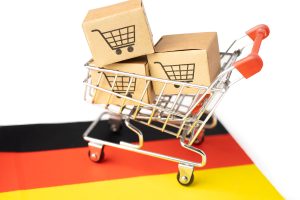Fulfillment vs. Dropshipping: Which is the Better Solution for E-Commerce in Germany?
The world of e-commerce is steadily growing, and with it, the variety of business models available to entrepreneurs. Two of the most prominent models often considered are fulfillment and dropshipping. Both have their specific advantages and challenges, especially in the German market. But which model is right for your business? In this blog, we will take a detailed look at fulfillment and dropshipping, compare both models, and provide decision-making assistance to help you find the best solution for your e-commerce business in Germany.
What is Fulfillment?

Fulfillment is a comprehensive process in which e-commerce companies outsource their warehousing, packaging, and shipping to specialized third-party providers. These fulfillment service providers, also known as fulfillment centers, handle the entire logistics process, allowing the company to focus on other aspects of the business. Once a customer places an order, this information is automatically transmitted to the fulfillment center, where the product is picked, packed, and shipped to the customer.
Advantages of Fulfillment
- Professional Storage and Packaging: One major advantage of the fulfillment model is the ability to utilize professional storage and packaging services. Fulfillment centers have specialized infrastructure and technologies that ensure products are stored under optimal conditions and carefully packaged. This significantly reduces the risk of damage during transportation.
- Fast Delivery Times: Since many fulfillment centers are strategically located—often near logistics hubs or urban areas—they can guarantee fast delivery times. In Germany, where expectations for fast delivery are high, this can be a significant competitive advantage.
- Scalability: Fulfillment solutions are highly scalable. Whether your business is growing or experiencing seasonal fluctuations, you can flexibly adjust your storage and shipping capacities without having to invest in expensive infrastructure. This is particularly valuable for companies that need to quickly respond to market developments.
- Cost Efficiency: At first glance, fulfillment may seem expensive, but when you factor in savings on staff, storage, and operating costs, it can become more cost-efficient in the long run. Additionally, many fulfillment providers offer volume-based pricing models, which can lead to significant cost reductions with larger shipping volumes.
- Customer Satisfaction: Using a professional fulfillment center can enhance customer satisfaction. Reliable delivery, professional packaging, and on-time shipping contribute to a positive shopping experience, making customers more likely to return for repeat purchases.
Example of Fulfillment Success
A good example of the successful use of fulfillment is the German company “Purelei,” which specializes in high-quality jewelry. Purelei started with small-scale, self-managed warehousing but quickly recognized the advantages of a fulfillment provider. By outsourcing logistics, the company was able to shorten delivery times and improve order processing efficiency. This not only led to more satisfied customers but also to a significant increase in sales.
What is Dropshipping?
Dropshipping is a business model in which the retailer does not hold any physical inventory. Instead, they sell products that are shipped directly from a third-party supplier to the end customer. Once an order is placed in the online store, it is automatically forwarded to the supplier, who ships the product directly to the customer. The retailer acts solely as a middleman without being involved in the logistics process.
Advantages of Dropshipping
- Low Startup Costs: Since no warehouse is needed, and products are only purchased after a customer places an order, the startup costs for dropshipping are very low. This makes the model particularly attractive for startups and small businesses working with limited budgets.
- No Inventory Management: One of the biggest advantages of dropshipping is that the retailer does not have to manage physical inventory. This eliminates the need to invest in warehouse space and manage stock, which is especially beneficial for businesses with a large product portfolio.
- Flexibility in Product Selection: Since the retailer only sells products that they do not need to store themselves, they can flexibly adjust their product range. New products can be easily added, and poorly selling items can be quickly removed from the offering without having to clear out inventory.
- Lower Risk: Since products are only purchased after the customer places an order, the retailer bears a lower financial risk. There are no unsold stocks that need to be written off.
- Focus on Marketing: Since the logistical effort is minimal, dropshipping retailers can focus entirely on marketing and customer service. This is particularly valuable in competitive markets, where customer acquisition is crucial to success.
Example of Dropshipping Success
A successful example of a dropshipping provider in Germany is “Berlin Brands Group” (BBG). BBG uses the dropshipping model to distribute a wide variety of niche products across multiple e-commerce platforms. Through smart marketing and the selection of the right products, BBG was able to build a strong market presence without having to hold large amounts of inventory.
Fulfillment vs. Dropshipping: A Direct Comparison
Now that we understand the basics of both models, let’s compare them directly to determine which one is better for your business.
- Inventory Management
- Fulfillment: With fulfillment, you need to manage your inventory and ensure that enough products are available to meet demand. This requires careful planning and management to avoid both overstocking and stock shortages. Warehouse costs can be considerable, especially with a large product range.
- Dropshipping: Dropshipping requires no inventory management, as products are shipped directly from the supplier to the customer. This means you don’t have to worry about warehouse costs, stock management, or clearing out inventory. However, the downside is that you have less control over stock availability, and delays may occur if the supplier runs out of stock.
- Initial Investment Costs
- Fulfillment: Initial investment costs in fulfillment are higher, as you need to rent warehouse space, hire warehouse staff, and invest in packaging and shipping materials. Additionally, there are monthly costs for storage and shipping.
- Dropshipping: The initial investment costs in dropshipping are significantly lower, as no warehouse space is needed, and you only pay for the products you actually sell. This makes dropshipping an attractive option for entrepreneurs with limited startup capital.
- Control Over the Customer Experience
- Fulfillment: With fulfillment, you have full control over the customer experience. You can ensure that products are professionally packaged and delivered on time. Additionally, you have the option to control the branding of your packaging and include personalized marketing materials.
- Dropshipping: In dropshipping, you give up much of the control over the customer experience to the supplier. This can lead to inconsistent packaging, longer delivery times, and a lower level of personalization. This can negatively affect customer satisfaction, especially if the supplier does not meet the same standards as your business.
- Scalability
- Fulfillment: Fulfillment solutions are generally highly scalable. As your business grows, you can easily adjust your storage and shipping capacities. However, you need to ensure that your fulfillment provider can keep up with your growth.
- Dropshipping: Dropshipping is inherently extremely scalable, as you don’t need additional warehouse space or staff to handle more orders. Your main focus is ensuring that your suppliers can handle the increased demand.
- Delivery Speed
- Fulfillment: Fulfillment centers are often strategically located to ensure fast delivery times. This is a key advantage, especially in the German market, where customers expect fast delivery times.
- Dropshipping: Dropshipping can result in longer delivery times, especially if the products are shipped from abroad. This can lead to customer dissatisfaction, as German customers are used to fast delivery times.
- Product Quality and Branding
- Fulfillment: With fulfillment, you have control over product quality and branding. You can ensure that only high-quality products are shipped and that your brand identity is maintained throughout the supply chain.
- Dropshipping: In dropshipping, there is a risk that product quality and branding may not meet your standards, as you have little control over the manufacturing process and packaging. This can lead to returns and negative reviews.
Advantages and Disadvantages of Fulfillment
Advantages:
- High control over storage, packaging, and shipping
- Professional branding and personalization possible
- Fast delivery times, especially with local storage
- Good scalability for growing businesses
Disadvantages:
- Higher initial and ongoing costs
- Complexity in inventory management
- Dependency on an external service provider for logistics
Advantages and Disadvantages of Dropshipping
Advantages:
- Low startup costs and low financial risk
- No need for inventory management
- Flexibility in product selection
- Easy scalability
Disadvantages:
- Little control over the customer experience
- Longer delivery times, especially with international suppliers
- Risk of lower product quality and inconsistent packaging
- Lower profit margins due to supplier dependency
Which Solution is Right for Your E-Commerce Business in Germany?

The choice between fulfillment and dropshipping depends on several factors, including the size of your business, your product range, your growth plans, and your customers’ expectations.
- Business Size: Small businesses and startups often benefit from dropshipping, as it requires low initial investments and is flexible. Larger companies or those with an established brand may prefer fulfillment to have more control over the customer experience.
- Product Range: If you want to offer a broad product range, dropshipping may be beneficial, as you don’t need to manage inventory. For businesses with a smaller, specialized range, fulfillment may be better to ensure quality and branding.
- Growth Plans: Companies with ambitious growth plans should consider fulfillment, as it is scalable and offers better control over logistics processes.
- Market Demands: In Germany, fast delivery times and high product quality are crucial. If these factors are central to your business, fulfillment may be the better choice.
- Customer Expectations: If your customers expect fast delivery and high-quality packaging, you should take advantage of the control that fulfillment provides.
Conclusion
The choice between fulfillment and dropshipping depends heavily on the individual requirements of your e-commerce business in Germany. Both models offer specific advantages, and the best solution can vary depending on your priorities—whether it’s cost, control, flexibility, or customer experience.
If you value control over your logistics and the customer experience and are willing to invest in professional solutions, fulfillment may be the right choice for you. If you prefer to start with low risk and maximum flexibility, dropshipping may be the better path.
Take action now! If you want to learn more about choosing the right logistics model for your business or are interested in our professional fulfillment services, contact us today for a non-binding consultation. We will help you find the perfect solution for your e-commerce business in Germany.
FAQs
-
Is Fulfillment suitable for small businesses in Germany?
Yes, fulfillment can also make sense for small businesses, especially if they want high control over the customer experience and are willing to invest in professional logistics services. -
Can I combine fulfillment and dropshipping?
Yes, some companies combine both models, shipping certain products through fulfillment and others via dropshipping, depending on stock availability and shipping requirements. -
What are the costs associated with fulfillment?
Fulfillment costs can vary and include storage fees, shipping costs, packaging materials, and service fees from the fulfillment center. It is important to carefully calculate these costs and compare them with expected sales. -
How do I find the right dropshipping supplier in Germany?
There are various platforms and directories that list dropshipping suppliers. Look for suppliers with good reviews, fast delivery times, and transparent pricing policies. -
How can I ensure the quality of my dropshipping products?
Test products before selling them to ensure they meet your quality standards. It can also help to work with suppliers who implement strict quality controls and have clear return policies.





